在react中,context是一種無需為每層組件手動添加props就能在組件樹之間進行資料傳遞的方法;context提供了一種在組件之間共享指定值的方式,而且不必顯式的通過組件樹的逐層傳遞props。

本教學操作環境:Windows10系統、react17.0.1版、Dell G3電腦。
react中context是什麼
Context 提供了一個不需要為每層元件手動新增 props,就能在元件樹間進行資料傳遞的方法。在典型的React 應用程式中,資料是透過props 屬性自上而下(由父及子)進行傳遞的,但這種做法對於某些類型的屬性而言是極其繁瑣的(例如:地區偏好,UI主題),這些屬性是應用程式中許多元件都需要的。 Context 提供了一種在元件之間共用此類值的方式,而不必明確地透過元件樹的逐層傳遞 props。
Context 什麼時候用?
Context 設計目的是為了共享那些對於一個元件樹而言是「全域」的數據,例如當前認證的使用者、主題或首選語言。舉個例子,在下面的程式碼中,我們透過一個「theme」 屬性手動調整一個按鈕元件的樣式
class App extends React.Component {
render() {
return <toolbar></toolbar>;
}
}
function Toolbar(props) {
// Toolbar 组件接受一个额外的“theme”属性,然后传递给 ThemedButton 组件。
// 如果应用中每一个单独的按钮都需要知道 theme 的值,这会是件很麻烦的事,
// 因为必须将这个值层层传递所有组件。
return (
<p>
<themedbutton></themedbutton>
</p>
);
}
class ThemedButton extends React.Component {
render() {
return <button></button>;
}
}
// 通过props传递:App -> Toolbar -> ThemedButton
// 如果嵌套很深,那么需要逐层传递props,即使中间不需要该props,显得很繁琐
使用context, 我們可以避免透過中間元素傳遞props
// Context 可以让我们无须明确地传遍每一个组件,就能将值深入传递进组件树。
// 为当前的 theme 创建一个 context("light"为默认值)。
const ThemeContext = React.createContext('light');
class App extends React.Component {
render() {
// 使用一个 Provider 来将当前的 theme 传递给以下的组件树。
// 无论多深,任何组件都能读取这个值。
// 在这个例子中,我们将 “dark” 作为当前的值传递下去。
return (
<themecontext.provider>
<toolbar></toolbar>
</themecontext.provider>
);
}
}
// 中间的组件再也不必指明往下传递 theme 了。
function Toolbar() {
return (
<p>
<themedbutton></themedbutton>
</p>
);
}
class ThemedButton extends React.Component {
// 指定 contextType 读取当前的 theme context。
// React 会往上找到最近的 theme Provider,然后使用它的值。
// 在这个例子中,当前的 theme 值为 “dark”。
static contextType = ThemeContext;
render() {
return <button></button>;
}
}
// 也可以使用 ThemedButto.contextType = ThemeContext;
#API介紹
React.createContext
#const MyContext = React.createContext(defaultValue);
建立一個Context 物件。當 React 渲染一個訂閱了這個 Context 物件的元件,這個元件會從元件樹中離自身最近的那個符合的 Provider 中讀取到目前的 context 值。
只有當元件所處的樹中沒有符合到 Provider 時,其 defaultValue 參數才會生效。這有助於在不使用 Provider 包裝組件的情況下對組件進行測試。注意:將 undefined 傳遞給 Provider 的 value 時,消費元件的 defaultValue 不會生效。
Context.Provider
<mycontext.provider></mycontext.provider>
每個 Context 物件都會傳回一個 Provider React 元件,它允許消費元件訂閱 context 的變更。
Provider 接收一個 value 屬性,傳遞給消費元件。一個 Provider 可以和多個消費元件有對應關係。多個 Provider 也可以嵌套使用,裡層的會覆蓋外層的資料。
當 Provider 的 value 值改變時,它內部的所有消費元件都會重新渲染。 Provider 及其內部 consumer 元件都不受制於 shouldComponentUpdate 函數,因此當 consumer 元件在其祖先元件退出更新的情況下也能更新。
Class.contextType
##掛載在class 上的 contextType 屬性會被重賦值為一個由 React.createContext() 所建立的Context對象。這能讓你使用 this.context 來消費最近 Context 上的那個價值。你可以在任何生命週期中存取到它,包括 render 函數中
import MyContext from './MyContext';
class MyClass extends React.Component {
componentDidMount() {
let value = this.context;
/* 在组件挂载完成后,使用 MyContext 组件的值来执行一些有副作用的操作 */
}
componentDidUpdate() {
let value = this.context;
/* ... */
}
componentWillUnmount() {
let value = this.context;
/* ... */
}
render() {
let value = this.context;
/* 基于 MyContext 组件的值进行渲染 */
}
// 或者如上边例子一样使用 static contextType = MyContext;
}
MyClass.contextType = MyContext;
Context.Consumerimport MyContext from './MyContext';
function ToolList() {
return (
<mycontext.consumer> /* 基于 context 值进行渲染*/}
</mycontext.consumer>
)
}
這裡,React 元件也可以訂閱到 context 變更。這能讓你在函數式元件中完成訂閱 context。 這需要函數作為子元素(function as a child)這種做法。這個函數接收目前的 context 值,並傳回一個 React 節點。傳給函數的 value 值等同於往上元件樹離這個 context 最近的 Provider 所提供的 value 值。如果沒有對應的 Provider,value 參數等同於傳給 createContext() 的 defaultValue。
Context.displayName
context 物件接受一個名為 displayName 的 property,類型為字串。 React DevTools 使用該字串來決定 context 要顯示的內容。
const MyContext = React.createContext(/* some value */); MyContext.displayName = 'MyDisplayName'; <mycontext.provider> // "MyDisplayName.Provider" 在 DevTools 中 <mycontext.consumer> // "MyDisplayName.Consumer" 在 DevTools 中</mycontext.consumer></mycontext.provider>
範例
##動態Context對於上面的theme 例子,使用動態值(dynamic values)後更複雜的用法
theme-context.jsexport const themes = {
light: {
foreground: '#000000',
background: '#eeeeee',
},
dark: {
foreground: '#ffffff',
background: '#222222',
},
};
export const ThemeContext = React.createContext(themes.dark); // 该处为默认值
import { ThemeContext } from './theme-context';
class ThemedButton extends React.Component {
render() {
let props = this.props;
// 获取到ThemeContext中的默认值
let theme = this.context;
return (
<button></button>
);
}
// static contextType = ThemeContext;
}
ThemedButton.contextType = ThemeContext;
export default ThemedButton;
# 在上面的例子中,我们通过 props 的方式向下传递一个更新函数,从而改变 App 中 themes 的值。我们知道,从一个在组件树中嵌套很深的组件中更新 context 是很有必要的。在这种场景下,你可以通过 context 传递一个函数,使得 consumers 组件更新 context theme-context.js theme-toggler-button.js app.js 为了确保 context 快速进行重渲染,React 需要使每一个 consumers 组件的 context 在组件树中成为一个单独的节点 如果两个或者更多的 context 值经常被一起使用,那你可能要考虑一下另外创建你自己的渲染组件,以提供这些值。 因为 context 会使用参考标识(reference identity)来决定何时进行渲染,这里可能会有一些陷阱,当 provider 的父组件进行重渲染时,可能会在 consumers 组件中触发意外的渲染。举个例子,当每一次 Provider 重渲染时,以下的代码会重渲染所有下面的 consumers 组件,因为 为了防止这种情况,将 value 状态提升到父节点的 state 里 【相关推荐:javascript视频教程、web前端】import { ThemeContext, themes } from './theme-context';
import ThemedButton from './themed-button';
// 一个使用 ThemedButton 的中间组件
function Toolbar(props) {
return (
<themedbutton>
Change Theme
</themedbutton>
);
}
class App extends React.Component {
constructor(props) {
super(props);
this.state = {
theme: themes.light,
};
this.toggleTheme = () => {
this.setState(state => ({
theme: state.theme === themes.dark ? themes.light : themes.dark,
}));
};
}
render() {
// 在 ThemeProvider 内部的 ThemedButton 按钮组件使用 state 中的 theme 值,
// 而外部的组件使用默认的 theme 值
return (
<page>
<themecontext.provider>
<toolbar></toolbar>
</themecontext.provider>
<section>
<themedbutton></themedbutton>
</section>
</page>
);
}
}
ReactDOM.render(<app></app>, document.root);
// 使用ThemeContext.Provider包裹的组件,可以消费到ThemeContext中的value
// 即Toolbar、ThemedButton中都可以使用this.context来获取到value
// 注意观察,更新state的方法是通过props向下传递,由子孙组件触发更新,下面会讲到通过context的方式传递更新函数
在嵌套组件中更新 Context
// 确保传递给 createContext 的默认值数据结构是调用的组件(consumers)所能匹配的!
export const ThemeContext = React.createContext({
theme: themes.dark,
toggleTheme: () => {}, // 定义更新主题的方法,向下传递
});
import { ThemeContext } from './theme-context';
function ThemeTogglerButton() {
// Theme Toggler 按钮不仅仅只获取 theme 值,它也从 context 中获取到一个 toggleTheme 函数(下面app.js部分)
return (
<themecontext.consumer>
{({theme, toggleTheme}) => (
<button>
Toggle Theme
</button>
)}
</themecontext.consumer>
);
}
export default ThemeTogglerButton;
import { ThemeContext, themes } from './theme-context';
import ThemeTogglerButton from './theme-toggler-button';
class App extends React.Component {
constructor(props) {
super(props);
this.toggleTheme = () => {
this.setState(state => ({
theme: state.theme === themes.dark ? themes.light : themes.dark,
}));
};
// State 也包含了更新函数,因此它会被传递进 context provider。
this.state = {
theme: themes.light,
toggleTheme: this.toggleTheme, // 定义更新函数,通过context方式向下传递
};
}
render() {
// 整个 state 都被传递进 provider
return (
<themecontext.provider>
<content></content>
</themecontext.provider>
);
}
}
function Content() {
return (
<p>
<themetogglerbutton></themetogglerbutton>
</p>
);
}
ReactDOM.render(<app></app>, document.root);
消费多个 Context
// Theme context,默认的 theme 是 "light" 值
const ThemeContext = React.createContext('light');
// 用户登录 context
const UserContext = React.createContext({
name: 'Guest',
});
class App extends React.Component {
render() {
const { signedInUser, theme } = this.props;
// 提供初始 context 值的 App 组件
return (
<themecontext.provider>
<usercontext.provider>
<layout></layout>
</usercontext.provider>
</themecontext.provider>
);
}
}
function Layout() {
return (
<p>
<sidebar></sidebar>
<content></content>
</p>
);
}
// 一个组件可能会消费多个 context
function Content() {
return (
<themecontext.consumer>
{theme => (
<usercontext.consumer>
{user => (
<profilepage></profilepage>
)}
</usercontext.consumer>
)}
</themecontext.consumer>
);
}
注意事项
value 属性总是被赋值为新的对象class App extends React.Component {
render() {
return (
<mycontext.provider>
<toolbar></toolbar>
</mycontext.provider>
);
}
}
class App extends React.Component {
constructor(props) {
super(props);
// 多次渲染,state 会被保留,当value不变时,下面的 consumers 组件不会重新渲染
this.state = {
value: {something: 'something'},
};
}
render() {
return (
<provider>
<toolbar></toolbar>
</provider>
);
}
}
以上是react中context是什麼的詳細內容。更多資訊請關注PHP中文網其他相關文章!
 react中canvas的用法是什么Apr 27, 2022 pm 03:12 PM
react中canvas的用法是什么Apr 27, 2022 pm 03:12 PM在react中,canvas用于绘制各种图表、动画等;可以利用“react-konva”插件使用canvas,该插件是一个canvas第三方库,用于使用React操作canvas绘制复杂的画布图形,并提供了元素的事件机制和拖放操作的支持。
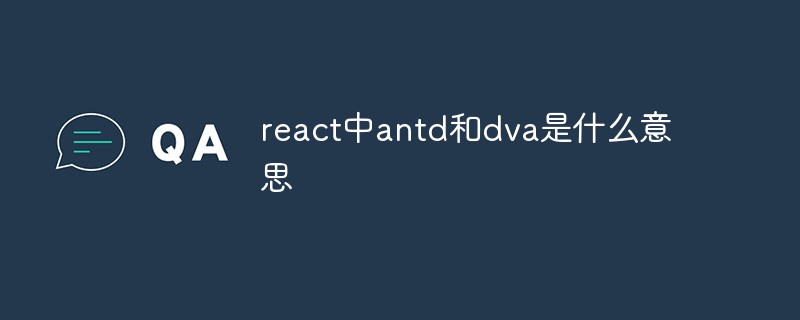 react中antd和dva是什么意思Apr 21, 2022 pm 03:25 PM
react中antd和dva是什么意思Apr 21, 2022 pm 03:25 PM在react中,antd是基于Ant Design的React UI组件库,主要用于研发企业级中后台产品;dva是一个基于redux和“redux-saga”的数据流方案,内置了“react-router”和fetch,可理解为应用框架。
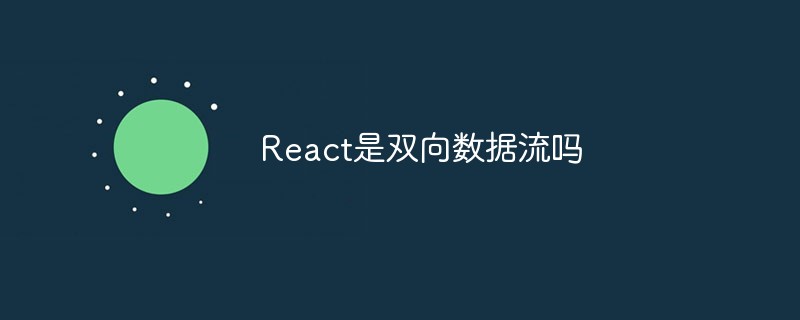 React是双向数据流吗Apr 21, 2022 am 11:18 AM
React是双向数据流吗Apr 21, 2022 am 11:18 AMReact不是双向数据流,而是单向数据流。单向数据流是指数据在某个节点被改动后,只会影响一个方向上的其他节点;React中的表现就是数据主要通过props从父节点传递到子节点,若父级的某个props改变了,React会重渲染所有子节点。
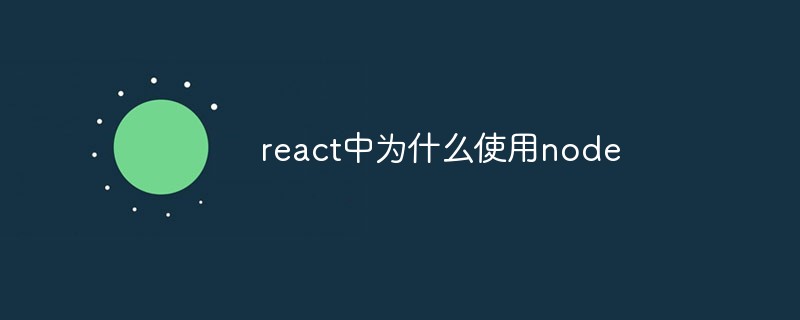 react中为什么使用nodeApr 21, 2022 am 10:34 AM
react中为什么使用nodeApr 21, 2022 am 10:34 AM因为在react中需要利用到webpack,而webpack依赖nodejs;webpack是一个模块打包机,在执行打包压缩的时候是依赖nodejs的,没有nodejs就不能使用webpack,所以react需要使用nodejs。
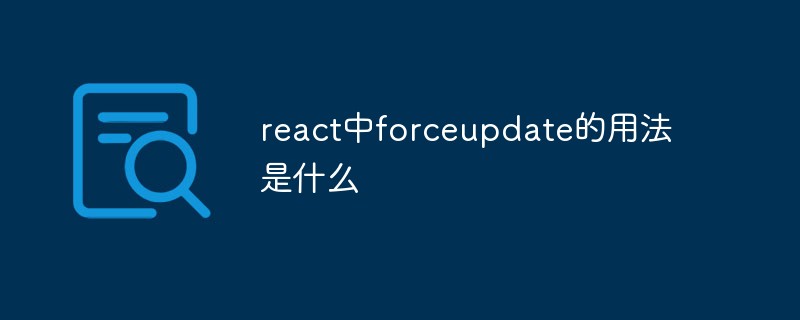 react中forceupdate的用法是什么Apr 19, 2022 pm 12:03 PM
react中forceupdate的用法是什么Apr 19, 2022 pm 12:03 PM在react中,forceupdate()用于强制使组件跳过shouldComponentUpdate(),直接调用render(),可以触发组件的正常生命周期方法,语法为“component.forceUpdate(callback)”。
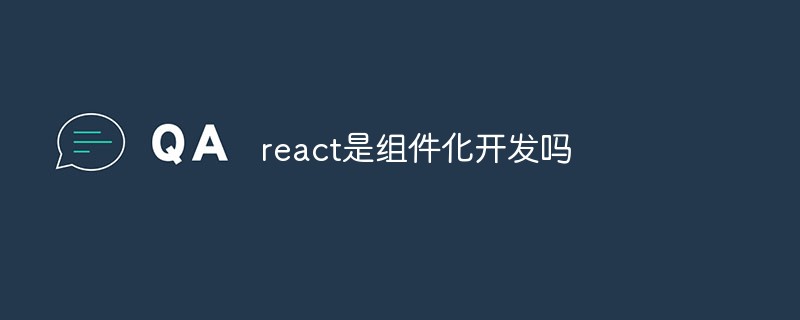 react是组件化开发吗Apr 22, 2022 am 10:44 AM
react是组件化开发吗Apr 22, 2022 am 10:44 AMreact是组件化开发;组件化是React的核心思想,可以开发出一个个独立可复用的小组件来构造应用,任何的应用都会被抽象成一颗组件树,组件化开发也就是将一个页面拆分成一个个小的功能模块,每个功能完成自己这部分独立功能。
 react和reactdom有什么区别Apr 27, 2022 am 10:26 AM
react和reactdom有什么区别Apr 27, 2022 am 10:26 AMreact和reactdom的区别是:ReactDom只做和浏览器或DOM相关的操作,例如“ReactDOM.findDOMNode()”操作;而react负责除浏览器和DOM以外的相关操作,ReactDom是React的一部分。
 react与vue的虚拟dom有什么区别Apr 22, 2022 am 11:11 AM
react与vue的虚拟dom有什么区别Apr 22, 2022 am 11:11 AMreact与vue的虚拟dom没有区别;react和vue的虚拟dom都是用js对象来模拟真实DOM,用虚拟DOM的diff来最小化更新真实DOM,可以减小不必要的性能损耗,按颗粒度分为不同的类型比较同层级dom节点,进行增、删、移的操作。


熱AI工具

Undresser.AI Undress
人工智慧驅動的應用程序,用於創建逼真的裸體照片

AI Clothes Remover
用於從照片中去除衣服的線上人工智慧工具。

Undress AI Tool
免費脫衣圖片

Clothoff.io
AI脫衣器

AI Hentai Generator
免費產生 AI 無盡。

熱門文章

熱工具

Dreamweaver Mac版
視覺化網頁開發工具

SublimeText3 Linux新版
SublimeText3 Linux最新版

SublimeText3漢化版
中文版,非常好用

SublimeText3 英文版
推薦:為Win版本,支援程式碼提示!

ZendStudio 13.5.1 Mac
強大的PHP整合開發環境






